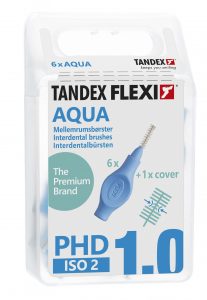The daily oral homecare routine is self-care
NewsPosted by: Dental Design 13th June 2021

Patients’ homecare routines have always been key to improving levels of oral health. Regular examinations at the practice are essential too, but even pre-Covid, “regular” could mean anything from every six to 18 months. For patients with very good levels of oral hygiene, adherence to preventive behaviours and low caries risk, the appropriate interval between appointments might even be as long as two years.[i]
Pre-Covid, people also found all sorts of reasons to delay routine “check ups” – anything from cost to anxiety or being too busy to make it. Others were unable to access an appointment when they wanted one. An area of great concern among the profession for many years, the pandemic has made access to dental care even harder, particularly for NHS patients, and practices will be dealing with the legacy of millions of missed dental appointments for a long time.[ii]
 With all the challenges we face, we must redouble our efforts to promote positive, preventive practises at home. Educating patients about how to elevate their homecare routine will not only reduce their need for treatment, and mean they need to attend for a routine assessment less frequently, it will also help them to become more engaged and motivated to take control of their oral health.
With all the challenges we face, we must redouble our efforts to promote positive, preventive practises at home. Educating patients about how to elevate their homecare routine will not only reduce their need for treatment, and mean they need to attend for a routine assessment less frequently, it will also help them to become more engaged and motivated to take control of their oral health.
A good oral homecare routine is part of self-care, which won’t just help patients avoid cavities and gingival inflammation. With its link to serious systemic diseases as well periodontal problems, it will also mean they can face the world with confidence. With social restrictions beginning to ease around the UK, what better way to re-enter society than with a dazzling smile to complement their long-overdue haircut!
So, what makes a good homecare routine? During your consultations, how many of your patients admit that theirs starts and ends with brushing their teeth? Correct toothbrushing, using the right technique, is at the very foundation of daily homecare, but it is just the first layer. Cleaning between the teeth using a specially designed tool to reach interdental spaces is the next, to remove optimal plaque and food debris. Interdental cleaning can help prevent gingival inflammation; the gumline being a vulnerable part of the mouth that can be hard to reach, even with the right-size brush applied at the right angle.
Traditionally, flossing was recommended as the way to effectively clean between the teeth. But oral health practitioners often found themselves fighting a losing battle when they suggested a patient use string floss. Many people found it tricky to master, fiddly and uncomfortable. But the new generation of interdental brushes can make the job easier, particularly for patients with limited dexterity. The latest interdental brushes are an efficient way to elevate daily brushing and keep the mouth healthy; they can be gripped firmly and manipulated into small spaces efficiently but gently, providing a practical, functional alternative to string floss.
Interdental brushes can also be used safely around orthodontic appliances and implants. They aren’t “one-size-fits-all”, because interdental spaces aren’t uniform either. This is about providing each patient with unique, tailored care by helping them find the best combination of tools for them.
 This is another benefit of supporting elevated homecare routines, it will enable good conversations that lead to better relationships with your patients. Better relationships always mean improved outcomes, because they’ll feel comfortable discussing every aspect of their oral health with you, in an honest and open way. When you ask a closed question like “Do you floss?”, we’ve all had patients who have answered “yes” when we suspect the real answer to be otherwise. If, instead, you ask if they’d like you to demonstrate how to use an interdental brush, they are likely to be more receptive to discovering a way to clean deeper, with a tool that they’ll find easy to use. For interdental brushes in a wide range of sizes, they could try the FLEXI™ from TANDEX, which comes in different diameters, defined as a PHD number displayed on the packaging, along with an ISO number from 0-8. The combination of PHD and ISO is identified by the colour of the brush handle. Your patients will appreciate that these brushes look elegant too – self-care, when you are consciously taking care of yourself and your wellbeing, should be based around things that are pleasing to all the senses.
This is another benefit of supporting elevated homecare routines, it will enable good conversations that lead to better relationships with your patients. Better relationships always mean improved outcomes, because they’ll feel comfortable discussing every aspect of their oral health with you, in an honest and open way. When you ask a closed question like “Do you floss?”, we’ve all had patients who have answered “yes” when we suspect the real answer to be otherwise. If, instead, you ask if they’d like you to demonstrate how to use an interdental brush, they are likely to be more receptive to discovering a way to clean deeper, with a tool that they’ll find easy to use. For interdental brushes in a wide range of sizes, they could try the FLEXI™ from TANDEX, which comes in different diameters, defined as a PHD number displayed on the packaging, along with an ISO number from 0-8. The combination of PHD and ISO is identified by the colour of the brush handle. Your patients will appreciate that these brushes look elegant too – self-care, when you are consciously taking care of yourself and your wellbeing, should be based around things that are pleasing to all the senses.
Interdental cleaning is simple, can be done comfortably every day and your patients will soon feel the benefits. Once a gold-standard routine is established, this is the gateway to discuss other things they can do to improve their health, looking at how to improve diet and nutrition for example. So, taking homecare routines beyond brushing is essential – for better long-term oral health outcomes, to reduce the need for treatment interventions and to lower a patient’s risk of other serious diseases.
For more information on Tandex’s range of products,
visit https://tandex.dk/ or visit the Facebook page
Author Kimberley Lloyd- Rees on behalf of Tandex
Kimberley graduated from the University of Sheffield in 2010, where she now works as a clinical tutor in Dental Hygiene and Therapy as well as working in practice. She has spent her career working across a variety of specialist private and mixed dental practices, for the MOD and volunteering her time to a dental charity in Nepal.
[i] Dental check-ups. NHS fact sheet. Link: https://www.nhs.uk/live-well/healthy-body/dental-check-ups/ (accessed April 2021).
[ii] Coronavirus: Dentists warn millions of treatments have been missed. BBC, 16 November 2020. Link: https://www.bbc.co.uk/news/health-54933313 (accessed April 2021).









